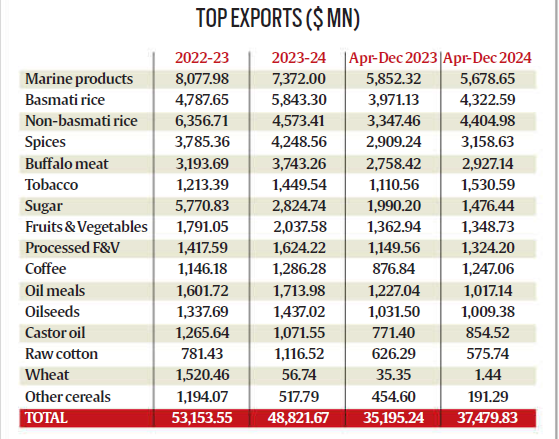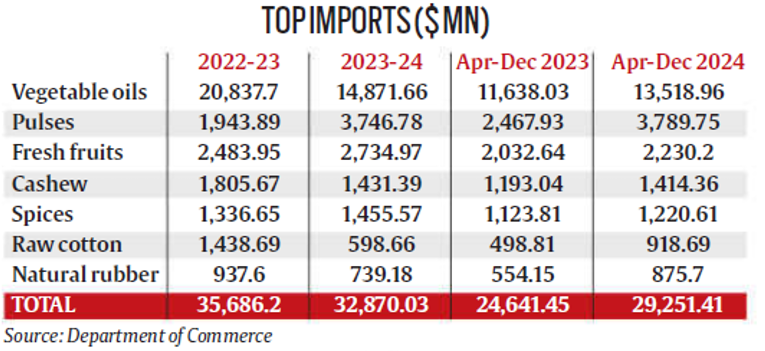India’s Agricultural Trade Surplus Shrinks as Imports Surge Amid Export Fluctuations
(Source – Indian Express, Section – Explained- Page No. – 14)
| Topic: GS3 – Agriculture |
| Context |
|
Analysis of the news:

Narrowing Agricultural Trade Surplus
- India’s agricultural exports rose by 6.5% in April-December 2024, surpassing the 1.9% overall merchandise export growth.
- However, agricultural imports surged by 18.7%, leading to a reduced trade surplus of $8.2 billion, down from $10.6 billion in the same period last year.
- This trend reflects India’s growing dependence on imported agricultural commodities, particularly edible oils and pulses.
Impact of Global Commodity Prices
- The agricultural trade surplus has fluctuated over the years, largely influenced by global price trends.
- A decline in international commodity prices between 2013-14 and 2019-20 reduced India’s export competitiveness while making imports cheaper.
- However, post-pandemic disruptions and geopolitical events like the Russia-Ukraine war led to a rebound in global prices, boosting exports to $53.2 billion in 2022-23.
- With global prices stabilizing in 2023-24, India’s exports have moderated, impacting the trade balance.
Key Export Drivers and Declining Sectors

- Strong Performers: Rice, spices, coffee, and tobacco exports have remained strong, benefiting from global supply shortages and India’s dominance in key markets.
- Declining Commodities: Marine products and sugar exports have seen a decline, with the latter impacted by government-imposed restrictions to control food inflation. Wheat exports have almost stopped due to domestic supply concerns.
Surge in Agricultural Imports

- Edible Oils: A major contributor to rising imports, with spending expected to be the highest since 2021-22 due to global price fluctuations.
- Pulses: A poor domestic harvest in 2023-24 has pushed imports past $5 billion for the first time.
- Spices & Cotton: India has become a net importer of pepper and cardamom, despite leading in other spices. Similarly, from being a major cotton exporter, India is now a net importer due to declining domestic production.
Conclusion:
- India’s agricultural trade dynamics highlight the need for strategic policies to boost exports and reduce import dependency.
- Enhancing domestic production of key imports like pulses and edible oils through technological interventions and improved productivity is crucial.
- Additionally, ensuring stable trade policies can prevent abrupt export restrictions that disrupt India’s competitive edge in global markets.
| Practice Question: India’s agricultural trade surplus has been narrowing due to rising imports and fluctuating exports. Analyze the factors contributing to this trend and suggest measures to enhance India’s agricultural export competitiveness while reducing import dependency. (150 Words /10 marks) |
